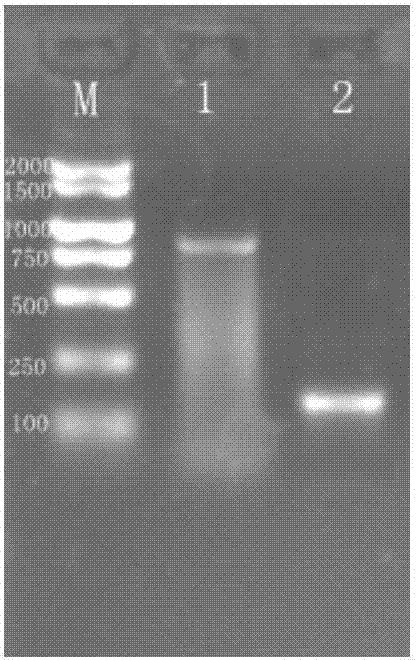Fluorescent quantitation PCR (photo-conductive relay) primer combination and method for rapid detection of dog babesia and kit with fluorescent quantitation PCR primer combination
A canis Babesia, fluorescence quantitative technology, applied in microorganism-based methods, biochemical equipment and methods, microorganisms and other directions, can solve the problems of detection speed and detection sensitivity need to be improved, and achieve simple method, strong specificity, good reproducibility
- Summary
- Abstract
- Description
- Claims
- Application Information
AI Technical Summary
Problems solved by technology
Method used
Image
Examples
Embodiment 1
[0040]The fluorescent quantitative PCR primer combination (as shown in SEQ ID NO:1,2) that is used for rapid detection of Babesia canis in the present embodiment, the nucleotide sequence is as follows:
[0041] Forward primer: 5'-TGTTGCAGTTAAAAAGCTCGTAGTTG-3',
[0042] Reverse primer: 5'-TCCATGCTGAAGTATTCAAGACACA-3'.
Embodiment 2
[0044] The kit used for rapid detection of Babesia canis in this example includes: 2×SYBR Master Mix 200 μL (purchased from Roche), 10 μL each of 20 μmol / L forward and reverse primers, 500 μL of deionized water, and Bessie worm 18S rRNA standard, DNAMarker and instruction manual;
[0045] The nucleotide sequence of the fluorescent quantitative PCR primer combination is as follows:
[0046] Forward primer: 5'-TGTTGCAGTTAAAAAGCTCGTAGTTG-3',
[0047] Reverse primer: 5'-TCCATGCTGAAGTATTCAAGACACA-3'.
[0048] Instructions for use: Use the total DNA of the blood sample to be tested as a template, and use the combination of fluorescent quantitative PCR primers to perform fluorescent quantitative PCR amplification; use the accumulation of fluorescent signals to monitor the entire PCR process in real time, and judge whether the sample contains canine by whether there is a specific amplification curve. Babesia; the reaction system is 20μL system: 2×SYBR Master Mix 10.0μL, 20μmol / L for...
Embodiment 3
[0076] 1. Incidence
[0077] A Teddy dog in Henan, female, 4 years old, was immunized according to the normal procedure. It is understood that the dog had been active in the mountains one week before the onset of the disease. When he returned home to bathe the dog, he found many ticks. The owner removed the ticks with his hands without knowing it. When he was seriously ill and was admitted to the hospital for treatment One tick was still found on the medial femur. According to the clinical observation, the dog was depressed, eating little or not, the urine was yellowish brown, the body temperature was as high as 40°C, the visible mucous membrane was pale, highly anemic, and the urine was the color of strong tea. No Babesia was found in the blood under the microscope. It is recommended to perform fluorescent quantitative PCR detection. The operation process is as follows:
[0078] (1) Sample DNA extraction
[0079] First, 300 μL of anticoagulated blood was collected from t...
PUM
 Login to View More
Login to View More Abstract
Description
Claims
Application Information
 Login to View More
Login to View More - R&D
- Intellectual Property
- Life Sciences
- Materials
- Tech Scout
- Unparalleled Data Quality
- Higher Quality Content
- 60% Fewer Hallucinations
Browse by: Latest US Patents, China's latest patents, Technical Efficacy Thesaurus, Application Domain, Technology Topic, Popular Technical Reports.
© 2025 PatSnap. All rights reserved.Legal|Privacy policy|Modern Slavery Act Transparency Statement|Sitemap|About US| Contact US: help@patsnap.com



